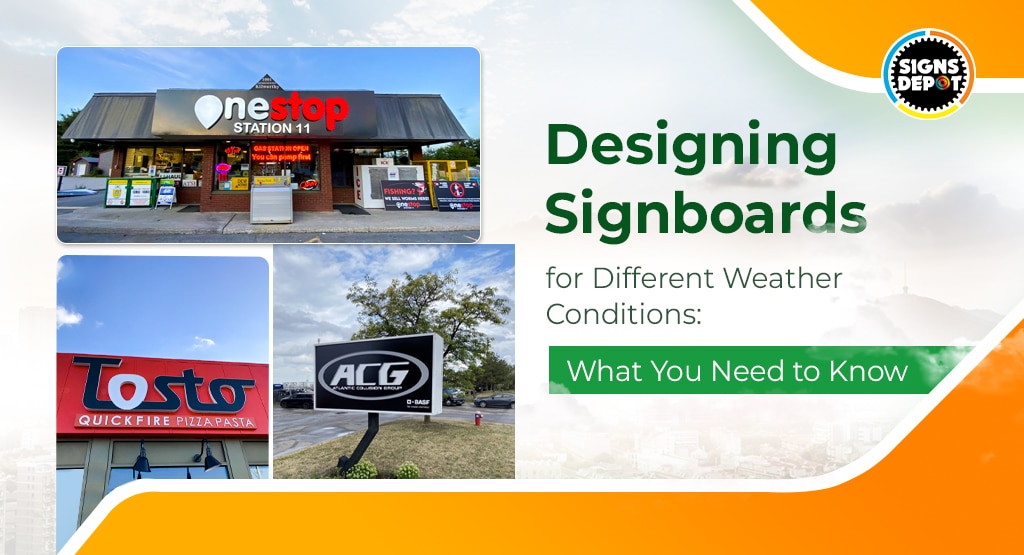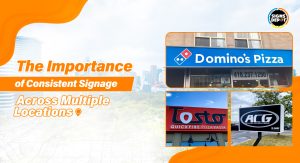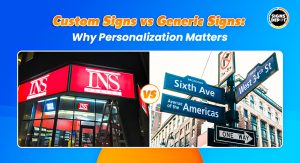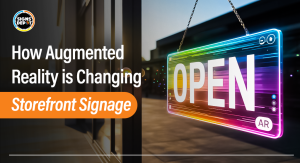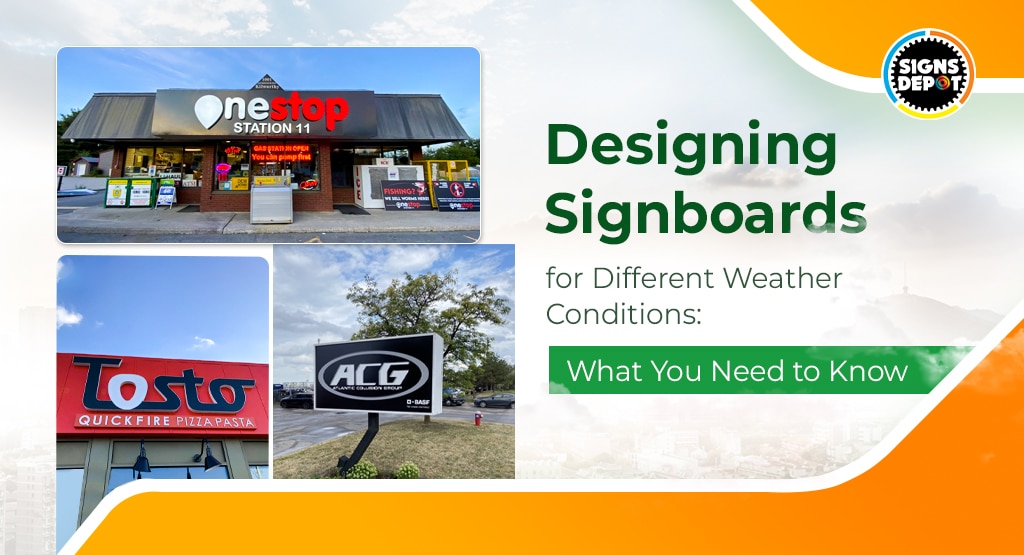
Let’s be honest—when was the last time you walked past a traditional signboard and actually noticed it? If you live in a place like Mississauga, chances are you’ve glanced at hundreds of them every week—on streets, storefronts, or while waiting at a red light. But here’s the thing: the weather has a huge say in whether you notice that sign or not. But if it is a digital signboard with flashy visuals, chances are you might not just glance at it, but it will also remain in your memory.
Yeah, weird, right? But hear me out. This is not just you but many others who are living in this city. When it’s snowing like crazy and your eyelashes are frozen, are you going to notice a dull, cracked sign with faded lettering? Nope. The same goes for a scorching summer day when the sun glares so hard off a glossy board that it blinds you. Or when it rains and the whole thing looks like someone used a Sharpie on soggy cardboard.
This is where weather-specific design comes in. If you’re designing or putting up a sign in Mississauga (or any city with mood-swing weather), you’ve got to think beyond fonts and colors. Let’s break it down.
1. Why Weather Matters in Sign Design
Mississauga isn’t exactly gentle when it comes to weather. We’re talking:
- Freezing winters with piles of snow
- Hot, humid summers
- Unexpected downpours in spring and fall
- The occasional brutal windstorm
Your sign has to stand up to all of that and still do its job—communicate a message clearly. No one’s going to squint at your sign for five minutes trying to figure out what it says, especially when it’s -10°C and snow’s smacking them in the face sideways.
2. Materials Make or Break the Sign
Let’s start with materials. You can’t just slap some cardboard or thin plastic on a pole and call it a day. Here’s what actually works:
Aluminum
Super popular, and for good reason. Doesn’t rust, is lightweight, and can survive rain, snow, and sun without falling apart. A lot of the Mississauga street signs you see—like those blue road name boards—are made of aluminum. Ever notice how clean and crisp they still look, even after winters that feel like they came straight from the Arctic? That’s no accident.
Acrylic
Great for indoor-outdoor transitions, like storefront signs under awnings. It’s strong, can be customized easily, and holds color well. So, use them to get the best lobby signs in Mississauga.
PVC and Dibond
PVC is affordable and decent for areas with less intense weather. Dibond is basically aluminum with a polyethylene core—super durable, used for higher-end signs that need to look good for years.
Wood or Basic Plastic
Nope. Don’t do it unless you want your sign to warp, crack, or fade in less than a year. Wood swells and splits when it rains, and plastic becomes brittle in the cold. Looks cute on Pinterest, not so much after a Mississauga snowstorm.
3. Don’t Forget the Finish
Once you’ve picked your material, you’ve got to protect it. That means weather-resistant finishes.
- UV-resistant coatings keep signs from fading in direct sun (a must in summer).
- Anti-graffiti laminates help with vandalism, especially in high-traffic areas or near bus stops.
- Waterproof laminates are crucial if your sign is fully exposed.
A local example? The Mississauga Celebration Square event signs are often printed on vinyl with UV and waterproof coatings. That’s how they survive days of blazing sun or sudden rainfall during summer concerts without curling up or turning into a blurry mess.
Recommended reading: How Digital Signage Is Changing the Way We Communicate
4. Fonts and Colors: It’s Not Just About Looks
When it comes to fonts, you want legibility, not artistic flair. Your fancy cursive might look cool on your laptop, but in fog, rain, or low light, it’s just… annoying.
Do:
- Use bold, sans-serif fonts like Helvetica or Arial
- Go for high contrast (white on black, black on yellow)
- Make sure the size is readable from a distance
Don’t:
- Use of script or overly decorative fonts
- Blend light colors with light backgrounds. For example, never use a pale color on a white background.
- Cram too much text. Trust me, no one is interested in reading too many text.
A perfect real-world example: those big digital signs outside Square One Shopping Centre. Even in the rain, from across the street, you can see the white-on-black promotions or announcements because they’re bold, high-contrast, and to the point. Now, that is the kind of signage that screams, it is created by Best signage company in mississauga.
5. Mounting and Positioning: Don’t Let the Wind Win
So your sign looks excellent until a gust of wind sends it flying down Hurontario Street like a confused frisbee.
Proper mounting is everything. Use heavy-duty brackets or poles, and make sure they’re rated for the wind conditions in your area. Signs that flap or tilt over time not only look bad, but they’re dangerous too.
A quick suggestion: Angle your sign just slightly downward if it’s high up. That way, rain and snow slide off, and glare from overhead lights or the sun is reduced.
6. Backlighting and Reflective Elements
Weather doesn’t just affect your sign—it affects visibility. A foggy morning? A snowy evening? Your unlit sign is basically invisible.
If your budget allows, consider backlit signs for 24/7 visibility, especially in busy areas or entrances. If lighting isn’t an option, use reflective vinyl—the same material road signs use. It catches headlights and ambient light so people can still read it in low visibility.
You’ll see this a lot in parking lot signage around Mississauga, especially near transit hubs or malls. Those signs don’t just light up for fun—it’s so people don’t crash into a pole or miss an entrance in low light.
7. Regular Maintenance means Longer Lifespan
Even the best lobby signs in Mississauga aren’t about “set it and forget it.” With changing seasons, your sign needs a little TLC:
- Wipe it down after winter (salt buildup is no joke)
- Re-tighten bolts or screws after windy months
- Touch up paint or replace vinyl if it starts peeling
Honestly, just a 10-minute monthly check-up can add years to your sign’s life and save you money in the long run.
8. Digital Signs? Cool, But Complicated
Thinking about going digital? Cool. LED signs can display multiple messages, change info on the fly, and look super modern.
But keep in mind:
- They need waterproof casing
- The screen should be anti-glare and UV-treated
- You’ll need backup power for outages (and those happen, especially during storms)
Mississauga Transit, for instance, uses digital signboards at major bus terminals. These are weather-sealed and built to withstand the Canadian elements while staying readable.
If you’re a small business, a digital sign is definitely a bigger investment—but it can pay off with dynamic messaging and attention-grabbing visuals.
Designing a sign isn’t just slapping some words on a board. Especially in a city like Mississauga, where the weather is unpredictable and often unforgiving, your sign needs to be a little warrior—able to withstand snow, heat, wind, and rain while still looking sharp and getting its message across.
So next time you’re planning signage—whether it’s for your store, a community event, or a new project—don’t just think about what looks cool. Think about what survives, what communicates, and most importantly, what actually works in real-world weather. Because let’s face it: the weather isn’t going to take a day off just so your sign can look cute.
At Signs Depot, we build signs that stand tall in Mississauga’s wildest weather—blizzards, heatwaves, and sideways rain included. We use materials like UV-protected vinyl, rustproof aluminum, and weather-warrior mounting systems that refuse to quit. Don’t gamble with cheap fixes. Get a quote today and let’s craft a sign that outlasts the harsh climatic conditions.

